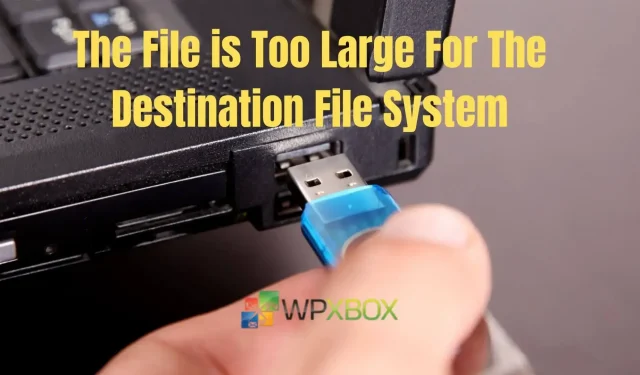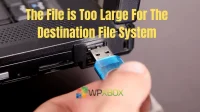When moving or copying large files larger than 4 GB to a USB flash drive or external hard drive, you receive an error – Is the file too large for the target file system? Then in this post, we will share the possible causes and solutions for this problem.
Reasons for the error
- Attempting to transfer a file that is larger than the maximum file size supported by the target file system: If the files you want to transfer are larger than 4 GB, attempting to transfer such files that are larger than the maximum file size supported by the target file system will result in an error.
- Attempting to transfer a file that is larger than the available free space on the target drive: The “File is too large for the target file system “error will appear if you save files larger than 2 GB to a FAT16 partition or more than 4 GB to a FAT32 partition. The best course of action in these circumstances is to convert the file systems.
Troubleshooting steps
- Check the maximum file size supported by the target file system. Before transferring files to a destination, check the maximum file size supported by the target file system. To use exFAT, you must format the target drive to NTFS. Unlike FAT32, NTFS and exFAT allow you to store files larger than 4 GB.
- Check the available free space on the target disk. To see the total available space, how much space has been used by different content and category types, and how much free space is left on your drive, go to Settings > System > Storage in Windows. PC.
- Try moving the file to a disk with a file system that supports larger files. To store huge data, change the target device’s file system to NTFS or exFAT.
- Divide the file into smaller parts and transfer them separately. If the file is too large, split or compress it before saving it to a USB flash drive. Although it is in FAT32 format, it is easier to save it to a USB device.
Fixed: file too big for target file system
1] Format the target drive with a file system that supports larger files.
The easiest way to migrate from FAT32 to NTFS is formatting with File Explorer. But remember that it will delete all current contents of the disk. As a result, this is only recommended if your external hard drive or USB drive doesn’t have all the files. You can back up any files that are already on your storage device by manually copying them or by using free backup software in advance. Here’s how to do it using the built-in Windows formatting feature.
- Start by connecting the USB to your computer.
- Right-click the drive and select the Format option from the context menu.
- Click the drop-down box under File System, select NTFS, and click the Start button.
2] Use a third party tool to split files
If you can’t or don’t want to format for any reason, you can use a file splitter software that can split the file and then merge it again. The easiest way to split files is to use any archivers.
Conclusion
Once you understand that the FAT32 file system is to blame for the file being too large for the target file system, the remedy is simple: switch to a different file system.
Before using any of the built-in features or Windows applications to convert the file system, you must back up the files on your storage device, as these steps will delete any existing files. Therefore, it is recommended to use a third-party tool to convert FAT32 to another file system directly without losing any data.


